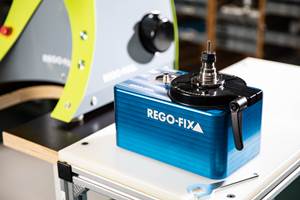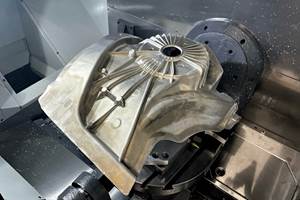Tips for Fine-Tuning RPM
Thoughtful considerations will set you on a shortened path to the most optimized solution once cutter meets metal.
Share



Autodesk, Inc.
Featured Content
View More
Takumi USA
Featured Content
View More




ECi Software Solutions, Inc.
Featured Content
View More
Hwacheon Machinery America, Inc.
Featured Content
View MoreReader Question: Like most machinists, I have handy speed and feed charts I trust to get started on a new process. However, I cannot seem to get the rpm right, and it always requires changes at the machine to fine-tune. Do you have some advice on how to best approach this and get better speeds on the first try?
Miller’s Answer:
When it comes to developing cutting parameters for a process, there are some methods I’ve come to rely on as I go through the exercise. Very generally speaking, chip load is more a function of the tool geometry and whether you are roughing or finishing, while depth of cut (axially and radially) is mostly a constraint of the available spindle power. RPM, for me, is always the most difficult to choose, because it relies on a more thoughtful consideration of the entire system to get it right. As such, I’ve refined my approach over time to zero in on a better starting rpm which considers as much of the system as reasonable, leaving a little room at the end for some refinement at the machine. This approach begins with the tool chart as with any machinist, but also weaves in the machine and toolholder limitations before a final confirmation at the machine.
First pass rpm
The first step is to find the nominal surface speed for the combination of tool and material. The tool manufacturer will typically have a range of surface speeds to choose from. It’s important to recognize that the provided ranges are usually quite large, as it’s meant to cover all conditions a tool may face, like a low-rigidity cut on a commodity machine, all the way to a high-performance cut in a premier machine tool. For starters, I usually just pick the number right in the middle.
Machine limits
After we have a first pass, we should consider machine limits. For example, is the calculated rpm over my maximum spindle speed? Do I have appropriate power/torque at that rpm to perform the cut I planned? If the toolholder arrangement is heavy, long or both, the machine tool may have a specific rpm range it should not to exceed with that combination. You should now adjust your first pass number up or down to get into a better power range and/or adjust (likely down) to accommodate those machine specific limitations.
Toolholder limits
With a new rpm number in hand, let’s now consider the toolholder itself. All toolholders will have some maximum guaranteed balance rating, say G2.5 at 10,000 rpm. If your current rpm is outside the desired level of balance, you will need to adjust rpm down. You could also balance the assembly via drilling or balance rings to satisfy the ideal rpm you wish to use for that cut. If resources permit, you may also wish to introduce harmonic measurements (for example, tap testing).
Tap testing?
You may ask, “Why not just tap test in the first place?” In my experience, tap testing works great, but it lacks some recognition of the broader system if you take the results as is. For example, it may suggest an rpm which fits the stiffness of the system, but may be outside of a safe rpm range for tool wear, balance, maximum spindle speeds, tool moment and so on. Therefore, I recognize it as an aid to better inform your decision on the best possible solution, but maybe not immediately the best solution in every case. If you have access to a tap tester, use it, but then compare the results with all the other known constraints as appropriate.
Verification
As a last bit of sanity, with the carefully chosen rpm which satisfies as many of the above-mentioned conditions as possible, you will want to reconfirm the surface feet per minute (sfm) of the tool at that rpm and compare this back to the cutting tool manufactures recommendations. As we’ve written before about tool life, too low of an sfm (cold) puts you at risk for built up edge in certain materials, and too high (hot) risks accelerated wear. At the very least, you will be able to know the risks prior to cutting and plan for them, even if further rpm adjustment isn’t desired.
Send it (carefully)
At this point you’ve settled on a “best case” rpm and it’s time to cut. Through all of that careful study, you may have an rpm that will hum along perfectly or at worst, it will be functional. The power of this exercise, though, is that by means of your study you will know very well where your left and right bounds exist. If you hear the cut and it sounds rough, and you have some room within the above parameters, you can confidently turn the rpm knob ±10% at a time until you’ve reached the solution the system likes. If you run out of safe space in the rpm range due to limits in any of the above limits, then you know confidently that the problem should be addressed via chip load or depth of cut, which saves troubleshooting effort.
Finally, take a moment to recognize you won’t know if it’s perfect until you cut a part. While you’ve focused on choosing the best possible starting rpm for your cuts considering the tool, toolholder and machine, you also need to consider other parts of the overall machining system, including the part and how you’re holding it.
Despite our best-laid plans, things like part weaknesses, workholding constraints or other unforeseen issues may necessitate further tuning or a different approach entirely. So why take all this effort in the first place? In my experience, thoughtful choices at the onset will set you up for more success and a shortened path to the most optimized solution once cutter meets metal. So study up and cut confidently.
Related Content
Five Common Mistakes Shops Make with ER Collets (And How to Prevent Them)
Collets play a crucial role in the machining process, so proper tool assembly and maintenance is important. Here are five potential pitfalls to avoid when using ER collets.
Read MoreFixturing Castings Made Simple Through Adhesive Workholding
When a casting proved too malleable for traditional gripping, Thomas/Euclid Industries adopted — and succeeded with — Blue Photon adhesive workholding.
Read MoreToolpath Improves Chip Management for Swiss-Type Lathes
This simple change to a Swiss-type turning machine’s toolpath can dramatically improve its ability to manage chips.
Read MoreSelecting a Thread Mill That Matches Your Needs
Threading tools with the flexibility to thread a broad variety of holes provide the agility many shops need to stay competitive. They may be the only solution for many difficult materials.
Read MoreRead Next
Registration Now Open for the Precision Machining Technology Show (PMTS) 2025
The precision machining industry’s premier event returns to Cleveland, OH, April 1-3.
Read More5 Rules of Thumb for Buying CNC Machine Tools
Use these tips to carefully plan your machine tool purchases and to avoid regretting your decision later.
Read MoreBuilding Out a Foundation for Student Machinists
Autodesk and Haas have teamed up to produce an introductory course for students that covers the basics of CAD, CAM and CNC while providing them with a portfolio part.
Read More




































.jpg;maxWidth=300;quality=90)







